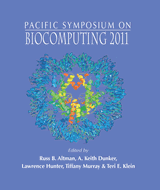Dynamic, Multi-Level Network Models of Clinical Trials
Marco D. Sorani1, Geoffrey T. Manley1, J. Claude Hemphill1, Sergio E. Baranzini2
1Department of Neurological Surgery and 2Department of Neurology University of California, San Francisco San Francisco, CA 94110, USA
Email: soranim@pharmacy.ucsf.edu
Pacific Symposium On Biocomputing 16:38-49(2011)

Abstract
While networks models have often been applied to complex biological systems, they are increasingly being implemented to investigate clinical questions. Clinical trials have been studied extensively by traditional statistical methods but never, to our knowledge, using networks. We obtained data for 6,847 clinical trials from five "Nervous System Diseases" (NSD) and five "Behaviors and Mental Disorders" (BMD) from the clinicaltrials.gov registry. We constructed networks of diseases and interventions for visualization and analysis using Cytoscape software. To standardize nomenclature and enable multi-level annotation, we used MeSH and UMLS terms. We then constructed separate BMD and NSD networks to study dynamics over time. To assess how topology features related to clinical significance, we constructed a sub-network of Multiple Sclerosis and Alzheimer's trials and identified which trials had been published in high-profile medical journals. We found that the BMD network has evolved into a large, decentralized topology and does not distinctly reflect the five diseases by which it was defined, while the NSD network does, though other diseases and sub-phenotypes have emerged as areas of research. We also found that high-profile trials have distinctive network characteristics. Future work is needed to address mathematical questions such as scale-dependence of network features, clinical questions such as trial design optimization, and methodological questions such as data quality improvement.
[Full-Text PDF] [PSB Home Page]